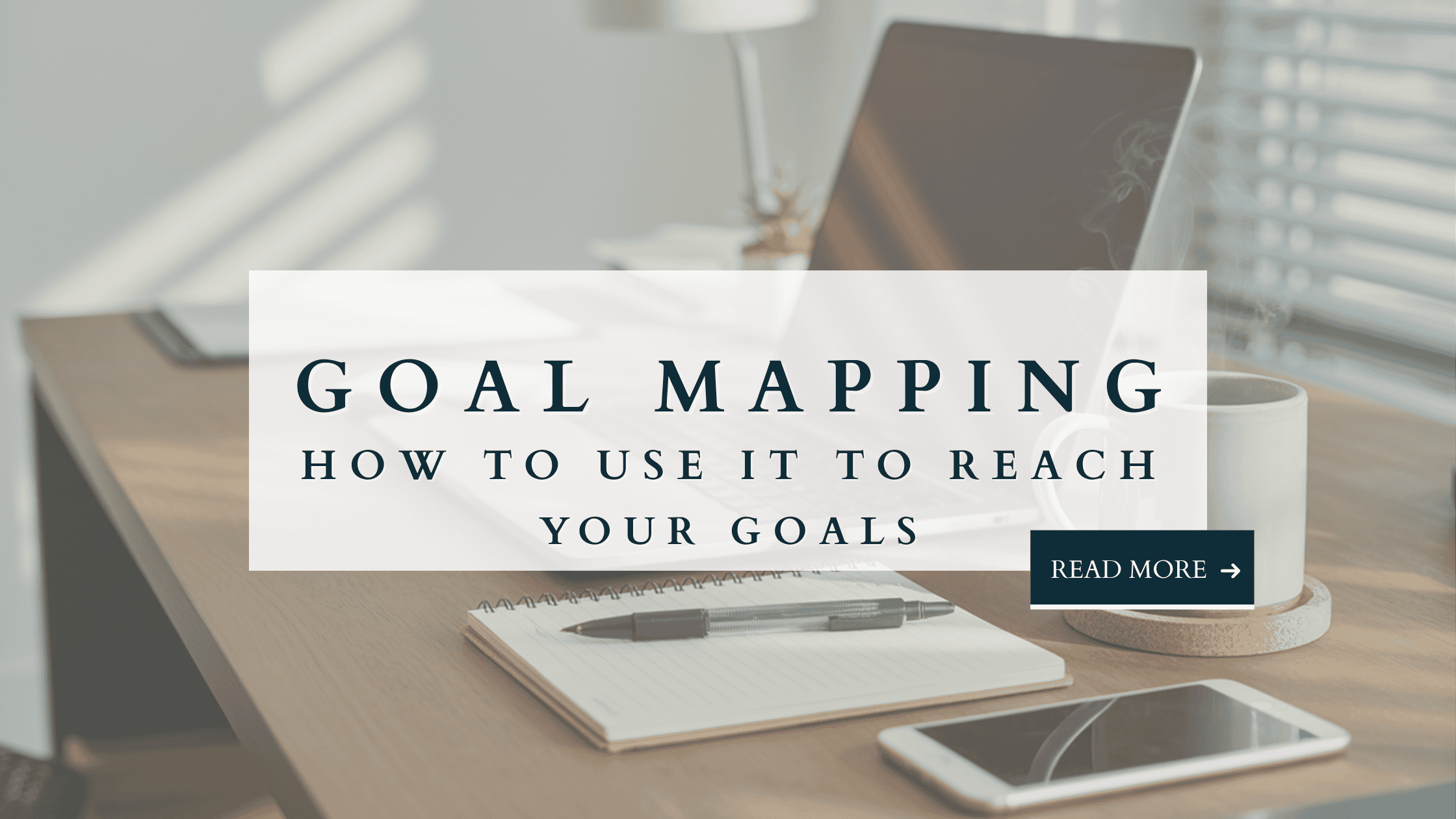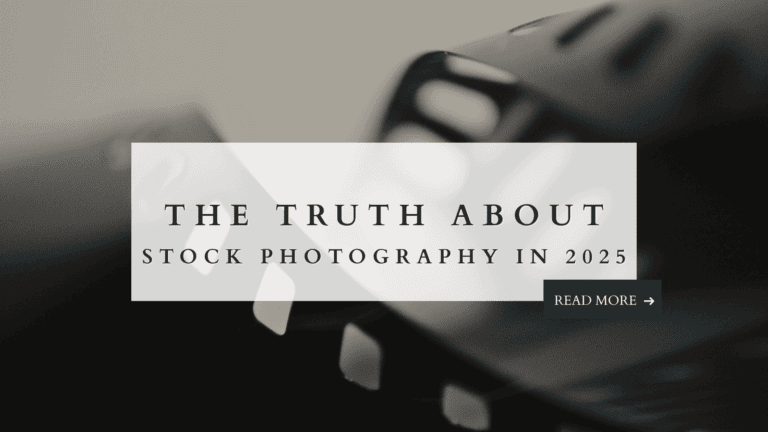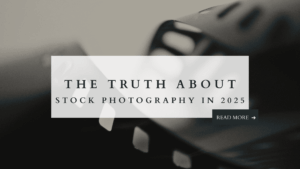In the world of photography, the path from where you are now to where you want to be can sometimes feel a bit blurry. You have dreams—whether it’s shooting for prestigious magazines, creating a steady stream of clients, or simply having more time for creative projects—but achieving these goals requires clarity and direction. This is where goal mapping comes in.
Unlike traditional goal setting, which often leaves you with a vague idea of what you want to achieve, goal mapping is a practical, visual tool that helps you create a clear roadmap towards your goals. If you want to learn how to use goal mapping to reach your goals, it’s a highly effective strategy for both personal goals and professional goals.
It’s a method that breaks your ambitions into manageable, actionable steps, keeping you focused and motivated along the way. Effective goal setting is essential, and whether you’re aiming for personal growth or business success, goal mapping is a strategy that can turn your dreams into tangible milestones—one step at a time.
BONUS PDF – FREE GOAL MAPPING WORKBOOK
What is Goal Mapping?
Become part of our VIP community today to receive exclusive offers, expert tips, and powerful strategies designed to boost your photography business. Don’t miss out on the insights that can help you succeed—sign up now!
Goal mapping is a visual method of setting and reaching goals. It involves creating a structured plan that clearly lays out what you want to achieve and the steps you need to take to get there. Unlike simple goal-setting, which can often be vague, goal mapping helps you break your larger ambitions into smaller, actionable steps, making it easier to see the path forward. By visually mapping out your goals, you create a roadmap that keeps you focused, motivated, and accountable, ensuring that both personal and professional goals become achievable milestones rather than distant dreams.
This visual goal mapping makes it easier to see how different goals support each other to help you reach your ultimate vision. Unlike traditional goal setting, goal mapping is a practical, visual tool that helps you create a clear roadmap to your goals. It helps you set out your goals and break them down into manageable goals, small goals, and even sub-goals of the small goals, which all help you towards achieving your ultimate goal.
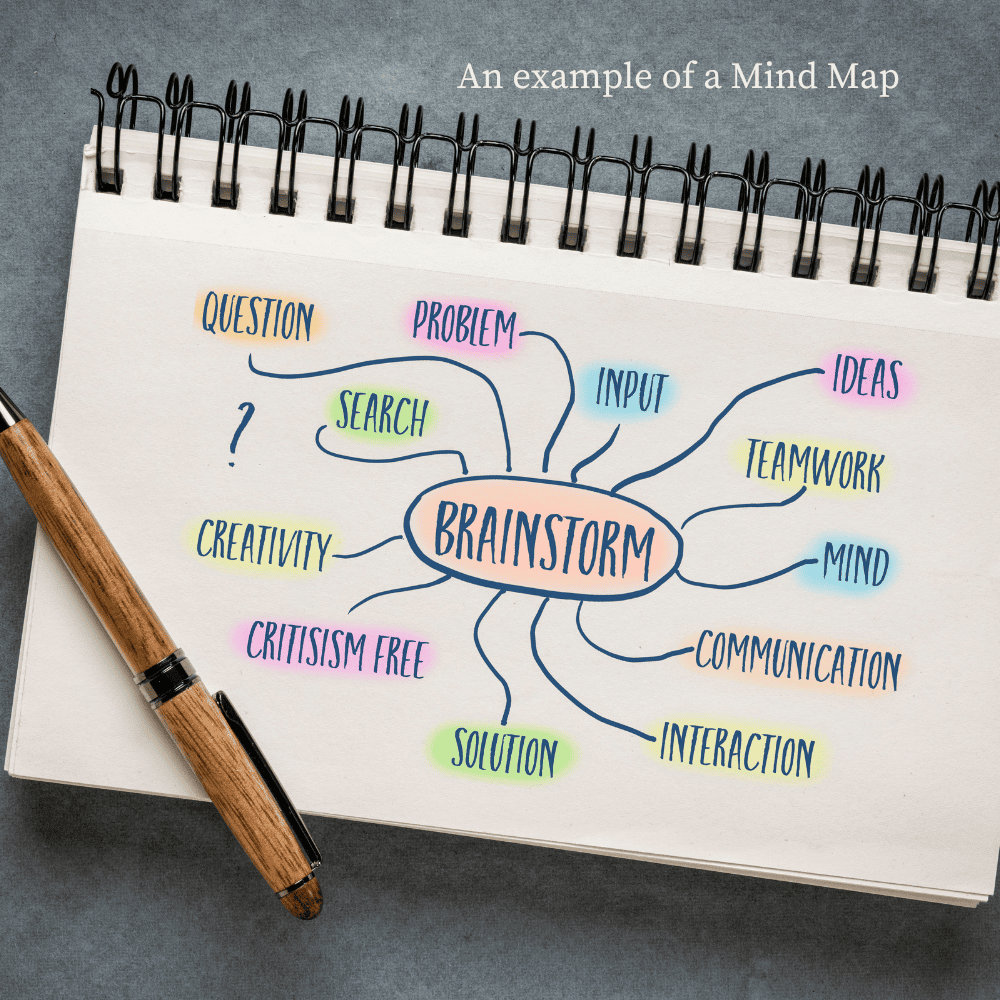
Why Goal Mapping Works for Photographers.
As visual creatives, photographers naturally resonate with goal mapping, which makes it particularly effective for our industry. The ability to see goals laid out visually provides a constant reminder of why you’re investing hard work and long hours, highlighting how every task contributes to your overarching vision.
For example, if your goal is to achieve a six-figure income from your photography business but you’re currently earning £30-40k, jumping straight to six figures isn’t realistic without a clear, actionable plan. Achieving this milestone requires breaking it down into smaller, manageable steps. Goal mapping helps you chart these steps, providing a structured approach to tackle daily tasks that steadily move you closer to your ultimate goal.
-
The best guide to becoming a Shutterstock Contributor
‘The best guide to becoming a Shutterstock contributor’ will give you all the steps needed, plus some extra tips and advice to help you become a Shutterstock contributor, start earning and stand out from the crowd. Originally set up in 2002 by programmer and photographer Jon Oringer, it remains one of the most popular stock…
-
The Truth about Stock Photography in 2025
I was doing some blog research recently around stock photography, and a question kept coming up: “Can you still make money with authentic lifestyle stock photos” As a stock photographer myself, I thought it was worth addressing it from someone whos understands and is actively submitting images for both commercial and editorial licenses. So, here…
The Goal Mapping Process Step-by-Step
Step 1: Define your goals.
The first step in the goal-setting process is to define your vision by identifying your main goal. What does success look like for your photography business or lifestyle? Take a moment to visualise it. Is it booking dream shoots, achieving a six-figure income, or simply having more time to focus on your creativity? Think both big and small—while the bigger picture might be about financial independence, smaller goals, like improving your editing workflow or setting up a home studio, are just as important. Having a clear vision ensures you’re aiming for the right goals—ones that align with your personal and professional aspirations.
Step 2: Break Down Your Goals.
Once your vision is clear, it’s time to break it down into smaller, actionable steps. Instead of setting a vague goal like “get more clients,” define specific goals that feel achievable. For instance, your next step could be to book three new portrait sessions a month, establish partnerships with local businesses, or refine your pricing strategy.
This process creates a structured action plan—a roadmap that outlines exactly what needs to be done to achieve your main goal. Smaller goals act as milestones, keeping you motivated and allowing you to track progress. Remember, even the most ambitious dreams can be tackled if they’re broken into manageable pieces.
Step 3: Map it Visually.
Visualising your plan is the key to staying organised and motivated. A visual road map helps you see how all the smaller goals connect to your main goal, making it easier to focus on what’s next. Use tools that suit your style—whether it’s jotting ideas on a whiteboard, creating a journal spread, or using digital tools like mind-mapping software.
- Whiteboard: Perfect for brainstorming and keeping your goals visible in your workspace. Use colour-coded markers to differentiate between steps, goals, and timelines.
- Journal or Planner: Great for mapping out your goals on paper. Create sections for your main goal, smaller goals, and actionable steps, and tick them off as you go
- Digital Tools: Applications like Trello, Asana, or Notion can help you organise tasks and track progress with ease.
- Mind Mapping Software: Tools like MindMeister or XMind are excellent for creating a visual representation of your goals, showing the connections between steps in a clear, structured way, or you can also use Canva as it has many templates you can use and edit to suit your needs.
For example, draw a central bubble with your main goal and branch out with smaller goals and the actionable steps required to achieve them. This visual approach ensures clarity and provides a quick reference point throughout your journey. By physically mapping out the goal-setting process, you’ll stay engaged and have a constant reminder of the progress you’re making.
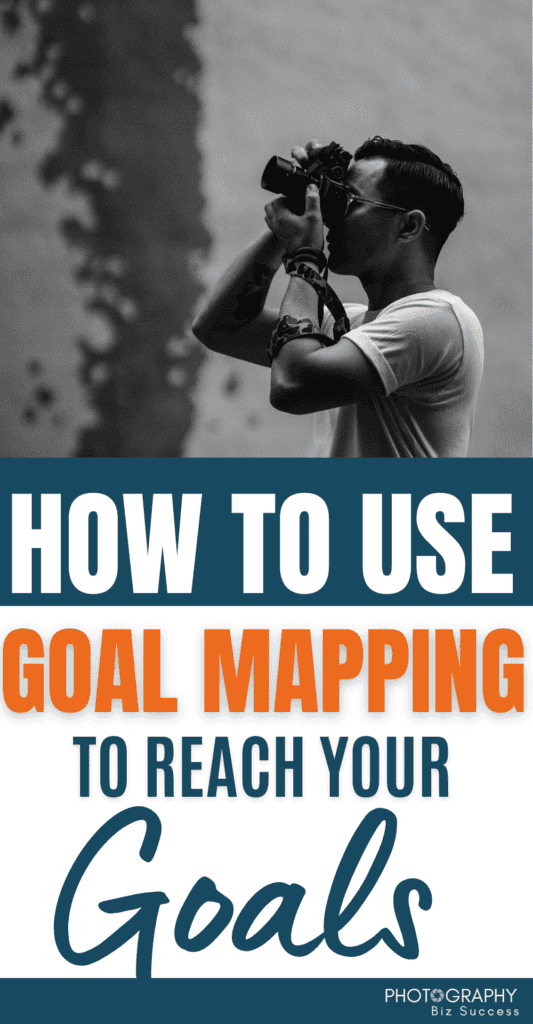
Tools & Strategies.
Too often when we think about and setting goals, we tend to be vague or set unrealistic objectives that lead to frustration or lack of progress. SMART goals is a framework to help set achievable, actionable and clear goals.
SMART stands for Specific, Measurable, Achievable, Relevant and Time-Bound. Each element works together to ensure that your goals are well defined, trackable and realistic giving you a clear roadmap to follow. Here’s how it aligns with each stage of goal mapping:
- Specific. In goal mapping, defining your vision starts with being clear about your main goal. The “Specific” aspect of SMART ensures that your goals are precise and focused, making them easier to visualise and map. Instead of saying, “I want to grow my photography business,” define a specific goal such as, “I want to book three new portrait sessions per month within the next three months.” • Action in Goal Mapping: Use this clear goal as the central focus of your map.
- Measurable. Goal mapping thrives when you break your larger vision into smaller, actionable goals that you can measure. The “Measurable” aspect ensures you can track your progress and celebrate milestones. Define metrics for each step, such as the number of new client inquiries, social media followers gained, or website visits converted into bookings. Add measurable outcomes to each branch of your map, such as “Increase website leads by 10% this month.”
- Achievable. The SMART framework’s emphasis on realism complements the goal-mapping process by keeping goals within reach. Breaking down big aspirations into manageable steps ensures they’re achievable. Assess your resources, time, and skills to ensure each smaller goal is realistic. For example, instead of aiming to book 50 clients immediately, focus on securing five consistent clients per month. Include realistic timeframes and resources needed for each step on your roadmap.
- Relevant. Goal mapping is about identifying the right goals—those that align with your bigger vision. The “Relevant” aspect ensures each goal contributes meaningfully to your main objective. Prioritise tasks and eliminate those that don’t directly impact your ultimate aim. For instance, if your main goal is financial growth, focus on high-return strategies like improving pricing or targeting premium clients. Create branches that directly support your main goal, removing unnecessary or low-priority tasks.
- Time-Bound. The goal mapping process benefits from time constraints, as they add urgency and keep you accountable. “Time-Bound” goals help set deadlines for each step. Assign deadlines for smaller goals, such as “Launch my new website within 30 days” or “Contact five potential collaborators by next Friday.” Include timelines for each branch of your map, ensuring every action has a clear deadline.
Overcoming Obstacles, Staying Focused & Flexible.
Obstacles are an inevitable part of any journey, and pursuing your business goals as a photographer is no exception. Whether it’s a lack of clients, unexpected expenses, or creative burnout, challenges can and will arise. The key to success isn’t avoiding these obstacles but knowing how to respond when they occur.
Don’t Panic—Pause and Refocus
When obstacles emerge, it’s easy to feel overwhelmed or frustrated. However, panicking only clouds your judgment. Instead, take a step back, reassess the situation, and remind yourself of your main goal. Staying calm and focused allows you to see the issue clearly and determine the best course of action. Revisiting your business goals will help you stay grounded and motivated to find solutions. Obstacles aren’t the end of the road—they’re just detours that require a little flexibility and problem-solving.
Prioritise the Most Important Tasks
Obstacles can often make everything feel urgent, but not all tasks are created equal. Focus on the most important tasks that directly impact your progress. For instance, if client inquiries are down, your immediate focus might be on refining your marketing strategy or reaching out to past clients. By tackling these action steps first, you’ll stay productive and keep moving forward, even in the face of challenges.
Build Contingency Plans Into Your Goal Map
A robust goal map isn’t just about reaching the completion date of your goals; it’s about being prepared for the unexpected. For every goal, consider what could go wrong and outline backup action steps to address potential issues.
For example:
- Goal: Book 10 portrait sessions in the next two months.
- Obstacle: Low client inquiries.
- Contingency Plan: Offer a seasonal promotion, partner with local businesses to reach new audiences, or boost social media advertising efforts.
- Goal: Launch a new service by a specific completion date.
- Obstacle: Budget constraints.
- Contingency Plan: Scale down initial offerings, prioritise cost-effective marketing strategies, or seek collaborations to share resources.
Having contingency plans ensures that when obstacles arise, you already have a roadmap for alternative paths to success.
Turn Obstacles Into Opportunities
Obstacles, while frustrating, often present opportunities to rethink your approach and improve your processes. By staying calm, prioritising the most important tasks, and focusing on your end result, you’ll turn challenges into stepping stones toward success.
Remember, every business journey comes with its share of bumps in the road. What sets successful photographers apart is their ability to stay flexible, act decisively, and keep moving forward, no matter the challenge. With a clear plan, contingency strategies, and a resilient mindset, you’ll be ready to overcome any obstacle that comes your way.
A Wedding Photographer’s Goal Mapping Journey Into Commercial Photography.
Emma is a successful wedding photographer who has built a profitable business over the years. However, she finds the demanding schedule of weekend weddings increasingly difficult to balance with her growing family. Wanting to prioritise more family time without sacrificing her income, Emma sets a primary goal: to transition her business focus to commercial photography, helping independent businesses grow through high-quality imagery, while maintaining her current income (£60,000 per year).
To achieve this, Emma uses goal mapping to break her ambitions into clear objectives, identify key steps, and create a clear path toward her new business direction.
Let’s take a look at Emma’s Goal Mapping.
Primary Goal: Transition to commercial photography within 12 months while maintaining current income.
Step 1: Set Clear and Measurable Goals
Emma establishes important goals that contribute to her primary goal:
- Research the photography needs of independent businesses in her area.
- Build a commercial photography portfolio to attract her target clients.
- Update her website and marketing materials to reflect her new services.
- Gradually reduce wedding bookings while growing her commercial client base.
- Network with local business owners to establish partnerships and expand her visibility.
Step 2: Break Down Goals into Key Steps and Specific Tasks.
Goal 1: Research local business photography needs.
- Conduct interviews with 10 independent business owners to identify their challenges and photography requirements.
- Analyse competitors in the commercial photography space to understand pricing and services.
- Completion date: Month 1
Goal 2: Build a commercial photography portfolio
- Offer discounted or complimentary sessions to five local businesses in exchange for portfolio usage.
- Create a series of mock branding projects to showcase her skills if real clients aren’t immediately available.
- Completion date: Month 2
Goal 3: Update website and marketing materials
- Add a new page highlighting her commercial photography services, focusing on how her work helps businesses grow.
- Develop case studies showing how professional imagery can elevate a brand.
- Completion date: Month 3
Goal 4: Transition from weddings to commercial photography.
- Limit wedding bookings to six for the year to free up time for commercial work.
- Shift marketing efforts, including social media ads and email campaigns, to target commercial clients.
- Completion date: Month 6
Goal 5: Network and establish partnerships.
- Join two local business networking groups and attend monthly meetings.
- Partner with a branding consultant or marketing agency to offer bundled services
- Completion date: Ongoing
Step 3: Build Contingency Plans
Emma plans for potential challenges to stay on track toward her important goals:
| Obstacle | Plan |
| Difficulty finding businesses for portfolio work. | Focus on mock projects or partner with friends who own small businesses to create professional examples. |
| Fewer commercial bookings than expected by Month 6. | Launch a targeted social media ad campaign and offer a limited-time promotion for first-time clients. |
| Income dips during the transition. | Accept two additional wedding bookings or offer mini branding sessions for small businesses as a quick income boost. |
These contingency plans give Emma a clear path to overcome obstacles while maintaining momentum.
Step 4: Visualise the Goal Map
Emma uses a journal to visually map her goals and tasks.
In the centre she writes her primary goal – “Transition to commercial photography within 12 months.”
She then has branches from the centre where she writes each key step, such as building her portfolio or networking.
She has some sub-branches with specific tasks under each objective, with deadline and progress markers.
She uses colour-coded markers to highlight completed goals and upcoming tasks, making it easy to see real progress at a glance.
Step 5: Focus on Adaptability and Progress
Emma knows flexibility is essential to achieving her goals. If a strategy doesn’t work as expected, she’s ready to pivot—whether it’s adjusting her services, extending a deadline, or exploring new marketing approaches. For example, if bookings are slow, she’s prepared to focus on targeted social media ads or offer seasonal mini-sessions to generate interest.
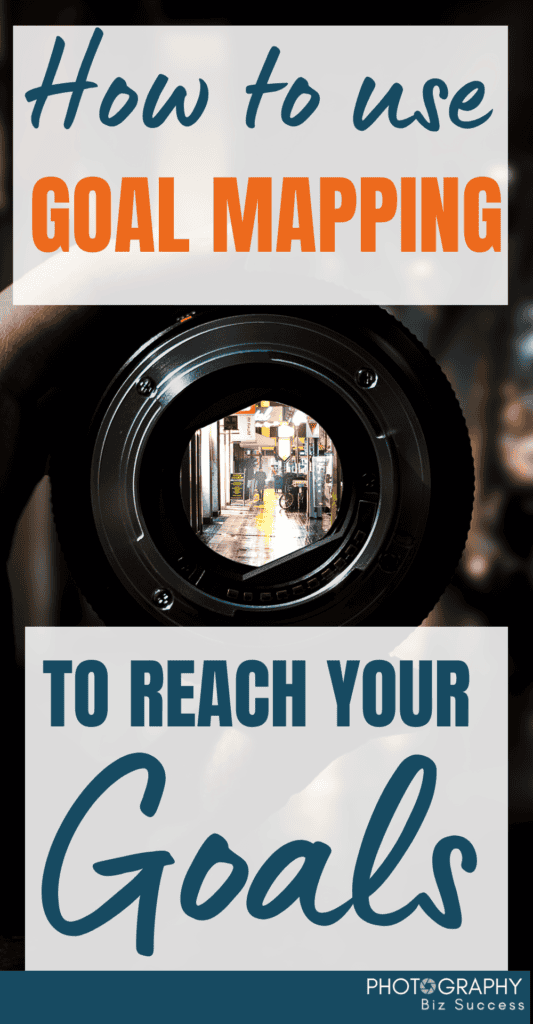
A Great Way to Stay on Track
Emma’s goal mapping ensures she has a clear path toward her primary goal, broken into measurable goals, specific tasks, and contingency plans. This structured approach helps her stay focused on her most important goals while giving her the flexibility to adapt when challenges arise.
By taking this step-by-step approach, Emma can confidently transition to commercial photography, maintain her income, and achieve the family time she values most.
Now It’s Your Turn!
Goal mapping doesn’t have to feel overwhelming. In fact, the best way to get started is to keep it simple. Pick one goal—whether it’s personal or professional—and begin mapping it out today. Creating your own goal map is a practical and empowering way to start moving in the right direction, turning your ambitions into actionable steps.
Set Realistic Goals to Build Momentum.
Big dreams are exciting, but breaking them down into realistic goals is the key to making progress. Choose a single, manageable goal to focus on. For example:
- Business Goal: Book two new clients this month by improving your social media outreach.
- Personal Growth Goal: Set aside 30 minutes a day for self-care or learning a new skill.
By starting small, you create achievable milestones that lead to success without feeling daunting.
Goal Mapping Isn’t Just for Business.
While goal mapping is an excellent tool for growing your photography business, it’s equally valuable for other areas of your life. You can use it to improve your work-life balance, enhance your health, or even achieve a personal passion project. Whether you want to spend more quality time with family, start a new fitness routine, or learn a new skill, the principles of goal mapping—setting clear objectives, breaking them into steps, and staying focused—apply universally.
Start Mapping Your Goal Today
Now is the perfect time to take action. Grab a notebook, a whiteboard, my mind mapping workbook or your favourite digital tool and create your own goal map for one specific goal. Set clear, realistic goals that feel achievable and outline the steps needed to reach them. It doesn’t have to be perfect—what matters most is that you’re starting in the right direction.
By focusing on one goal at a time, you’ll build confidence and momentum, making it easier to apply goal mapping to other areas of your life. Remember, small steps today lead to big results tomorrow. Start mapping, and see where your journey takes you!
Are you ready to take action and start mapping out your goals? Download your free Goal Mapping Workbook now and take the first step towards achieving your most important goals – both in your photography business and life!
BONUS PDF – GOAL MAPPING WORKBOOK
Many thanks for reading. Please let me know if I can help with the success of your Photography business or your Etsy shop.
Have you checked out the latest products in my shop? Click here to check it out!
Nicky x

-
The best guide to becoming a Shutterstock Contributor
‘The best guide to becoming a Shutterstock contributor’ will give you all the steps needed, plus some extra tips and advice to help you become a Shutterstock contributor, start earning and stand out from the crowd. Originally set up in 2002 by programmer and photographer Jon Oringer, it remains one of the most popular stock…
-
The Truth about Stock Photography in 2025
I was doing some blog research recently around stock photography, and a question kept coming up: “Can you still make money with authentic lifestyle stock photos” As a stock photographer myself, I thought it was worth addressing it from someone whos understands and is actively submitting images for both commercial and editorial licenses. So, here…

